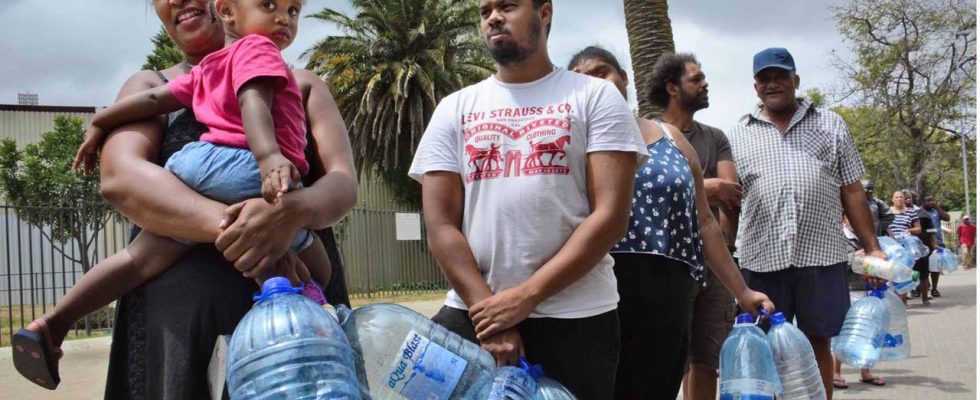Dilapidated infrastructure, sabotage, corruption – the water crisis in South Africa has the same reasons as the electricity crisis. But now the enormous lack of water is causing people even greater concern.
South Africa loses 70 million liters of drinking water every day due to burst pipes. You first have to be aware of the number.
Other numbers too – “two billion”, for example. The state water supplier Johannesburg Water announced in mid-September that the city was short of two billion liters of water every day. Or the number 10,957. According to official information, this is the kilometer length of water pipes that need to be repaired in the greater Johannesburg area alone – but are not.
No water for two weeks a month
The residents are angry. Sandra Amadio, who lives on the eastern edge of downtown Johannesburg, has been without water since September 14th. “It wasn’t much better before,” she told the news portal Daily Maverick. For years she has been used to having no water for at least four days a month. “In my area it’s now always two weeks a month.”
Funkinkosie Schriber, a resident from the same district, said she immediately gave up on hygiene for herself and her children: “We haven’t showered for a long time. And I don’t even want to describe to you what the lack of water is doing to our toilets .”
At the Rahima Moosa Mother and Child Hospital on the western edge of Johannesburg, they have drilled a well and are having water delivered in tankers, otherwise they would not be able to continue operations.
No extinguishing water for fires
Schools are also affected, many had to close in mid-September. A teacher at St Theresa’s College in the same district told Daily Maverick that the water supply cuts had hit students hard in recent weeks. “The water is suddenly turned off and students are not told why. They have no water to wash their hands. Going to the toilet has become inconvenient.” He thinks it’s inhumane not to have running water and says: “Without water, it also does immense damage to education; the children can no longer concentrate.”
A number of fires in the city of Johannesburg could not be extinguished in recent weeks because there was no fire-fighting water. In many households there are dozens of five-liter canisters, filled long in advance so that the essentials can be taken care of.
17 million people are affected in the greater Johannesburg area. For them, as for all South Africans, “Level 1” on the prohibition scale now applies: no washing the car with the hose, no watering the garden, only showering for two minutes a day. But who is supposed to control that? The restrictions are scheduled to remain in effect until March 31, 2024.
Dilapidated infrastructure, sabotage, corruption
The reasons for the water crisis are the same as those for the electricity crisis: dilapidated infrastructure, sabotage, corruption. In many cities and communities, the water pipes and sewerage systems date back to the 1950s. For decades they have been poorly maintained, often not at all.
The South African Human Rights Commission has commissioned a report in the megacity of Durban on the Indian Ocean. The result: the water infrastructure has been neglected for decades, mafia-like organizations dominate the system, and a catastrophe is imminent. In addition, water pipes are being tapped illegally in thousands of places across the country.
A sewage treatment plant in the capital Pretoria was to be renovated; the tender was worth many millions of euros. The money disappeared, nothing was repaired, and the water quality deteriorated rapidly. A few months ago, cholera broke out in a township near Pretoria, 15 people died and dozens had to be hospitalized. Cholera infections usually occur through contaminated water.
Water supplier blames people
The water supplier Rand Water, which owns Johannesburg Water, initially blamed the citizens. They would use too much water. In addition, a storm destroyed a lot of infrastructure.
That’s nonsense, says water expert Anthony Turton. “We cannot blame the citizens for the crisis. It is the city and municipal administrations that have failed. The government must quickly invest in new infrastructure, local taxes must be increased, as well as the price of water.
El Niño is coming soon
South Africa is one of the driest countries in the world; it rains only half the global average. In recent years it has actually rained enough and the storage tanks are full. But El Niño is expected to come from 2024. The weather phenomenon will also lead to more dryness in many parts of South Africa, especially in the north and interior of the country.
Optimists believe that there will be no serious consequences for South Africa from El Niño in the southern hemisphere this summer. But at the turn of 2024-2025 things could look completely different. “Level 6” of the restrictions would then mean that private households would have to reduce their water consumption by 45 percent – and agricultural operations by even 60 percent.

